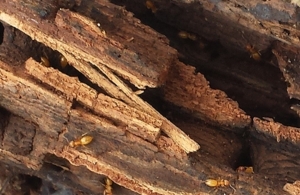A group that includes both larger and smaller yellow ant species, citronella ants’ common name comes from the lemon or citronella odor that is emitted when they feel threatened. The distinct smell is most prominent when the ants are crushed. Both species are found throughout a majority of the United States. Often mistaken for termites during swarming activity within homes, citronella ants swarmers are typically light yellow to amber in color. Workers are usually less varied in color and are usually yellow in color. Depending on their species, these ants range in size from 3 to 4.5 mm in length. Spare, erect hairs are found on the head, thorax and abdomen of both species.
Citronella ants are subterranean, meaning that they live below ground level. Little information is available about the life of these ants within their colony. It is believed that the ants tend to aphids and collect the honeydew that they excrete as their only source of food. Colonies are commonly located in pastures, fallow fields, gardens, under large rocks and below decaying logs. In addition, colonies may be located beneath concrete slabs, which is commonly the case when the ants are encountered in or around structures. A majority of swarms are encountered from mid to late summer; however, swarms have been seen in homes from early spring to late autumn. In the event that swarms occur repeatedly, attempts should be made to locate the colony as it is likely to be close to or under the foundation of the structure. Citronella ants are considered only as a nuisance as they do not attack food products the way that a vast majority of ant species do, nor will the reproduce indoors. Citronella ants, like many other species, deposit excavated soil near the entrance of the colony creating a mound. Due to their consistent food source of only the honeydew from aphids, baits are unsuccessful in treating citronella ants as the ants will not view the bait as a potential food source. Therefore, insecticides must be applied directly into the entry points of the colony. Pest control professionals have the specialized equipment, materials and knowledge that may not be available to the general public in order to properly treat citronella ant colonies.
